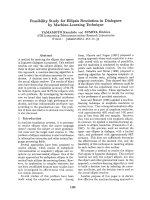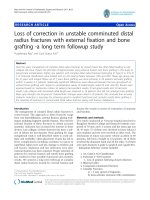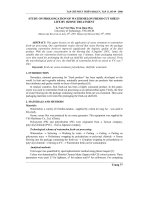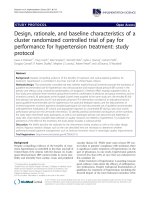Treatment Study for unstable pelvic ring fractures by external fixation = Nghiên cứu điều trị gãy khung chậu không vững bằng khung cố định ngoài (tóm tắt + toàn văn)
Bạn đang xem bản rút gọn của tài liệu. Xem và tải ngay bản đầy đủ của tài liệu tại đây (447.89 KB, 23 trang )
MINISTRY OF EDUCATION AND TRAINING MINISTRY OF NATIONAL DEFENSE
VIETNAM MILITARY MEDICAL UNIVERSITY
NGUYEN NGOC TOAN
STUDY ON TREATMENT UNSTABLE PELVIC RING FRACTURE
BY EXTERNAL FIXATION
Speciality: Orthopaedic Trauma and Reconstructive Surgery
Code: 62 72 01 29
SUMMARY OF DOCTORAL MEDICAL DISSERTATION
Hanoi - 2014
THE WORK HAS BEEN COMPLETED AT VIETNAM MILITARY
MEDICAL UNIVERSITY
Scientific instructors:
1. Prof, PhD. Nguyễn Tiến Bình
2. Assoc. Prof., PhD. Phạm Đăng Ninh
Opponent 1: Assoc. Prof, PhD. Đao Xuan Tich
Opponent 2: Assoc. Prof, PhD. Lưu Hong Hai
Opponent 3: Assoc. Prof, PhD. Nguyen Xuan Thuy
The dissertation will be defended in presence of the University Level Dissertation
Assessment Council
At………… on………
References at:
1. National Library of Vietnam
2. Library of Vietnam Military Medical University
3. Library of Cho Ray Hospital
LIST OF SCIENTIFIC WORKS
ANNOUNCING RESULTS OF THE DISSERTATION THEME
1. Nguyen Ngoc Toan (2013); “Lesions characteristic of anatomy of unstable
pelvic ring fractures”, Vietnam Medicine, Volume 408 (2), page 43 – 48.
2. Nguyen Ngọc Toan, Pham Dang Ninh, Nguyen Tien Binh (2013);
“Outcomes of treatment unstable pelvic ring fracture by external fixation”, Vietnam
Medicine, Volume 409 (1), page 101 – 105.
1
ABSTRACT
Pelvic fractures are common injuries with a rate of 23-37/100.000 in one year.
According Failinger (1992), pelvic fractures account for 1 - 3% of all fractures and
approximately 2% of hospital admissions caused by trauma. Demetriades (2002) and
another study showed that pelvic fracture rates from 5 to 9.3% of all fracture types
including traumatic shock rate accounts for above 40%. According to the statistics of
Larry (1994), Ganssen (1996), Chueire (2004) and Barzilay (2005), Zsolt (2007), the
pelvic fracture had percentage from 40 to 55.2% of the type of pelvic trauma. This is
seriously injured, complex, with high mortality rate, and especiallly, the number of
pelvic trauma was as much as traumatic brain injuries, ranging from 10-20% of the
pelvic fracture. In particular, the group with open pelvic fractures have ratio from
20% to 50%. In Vietnam, Ngo Bao Khang (1995) and Nguyen Duc Phuc (2004)
reported rate of pelvic fractures account for 3-5% of all fracture types, but it had no
statistics about mortality.
Using external frame to fix the pelvic fracture is very simple and safe, and this
technique can be applied at where hospital have an orthopaedic specialist. Many
authors suggest that, as early pelvic fractures was fixed, pain relief will achieve
effectively. It’s helpful to control of bleeding and preventing traumatic shock injuries.
When fractures was fixed, patients have early mobilization and comfortable
conditions that the wound was faster recovery.
In recent years, at the Department of Orthopaedic Trauma Cho Ray Hospital,
orthopadics have treated patients with unstable pelvic fractures by frame outside the
quadrilateral shape. With this approach, pelvic has corrected for anatomy recovery
relatively. With this method, a treatment comes from clinical practice that we thought
to anatomy characteristic injury of unstable pelvic fractures in order to improve
efficiency and better treatment. That is why we carried out the study: "Study on the
treatment unstable pelvic ring fractures by external fixation" for two goals:
1. Survey lesions characteristic of anatomy of unstable pelvic ring fractures.
2. Evaluation outcomes treatment of unsntable pelvic ring fractures by external
fixation and commented some factors affecting treatment outcomes.
2
Chapter I
OVERVIEW
1.2 . Pelvis Fracture Injury.
Pelvic fractures are usually divided into categories :
- Open and closed fractures of the pelvis.
- Stable and unstable pelvic fractures.
- Partial fracture of the pelvis is small lesions such as iliac crest, pubic bone,
ischium, sacrum or coccyx
- Acetabular fracture is a particular fracture of the pelvis relating to the hip.
So the classification and treatment differ from pelvic fractures significantly.
Currently, the authors agree acetabular fractures classified as a separate type.
1.2.3. Morphology pelvic fracture injury.
* Pelvic Injuries
- Tile (1984, 2003) [147, 150], from the previous 70 years of the twentieth
century, assessed anatomy of pelvic fractures were less intent in study because the
majority of patients with pelvic fractures were used conservation treatments. It is very
little cases of surgical treatment and the studying on cadaver pelvic fracture basically.
- Malgaigne (1859) describes pelvic fractures in which anterior lessions
(disruption of the symphysis, inferior and superior pubic) and posterior lession
(vertical ileum disruption, SI joint dislocation), 1/2 pelvic displaced upwards by
muscles contracting [96]. Since 1980, people has started research on lesions of the
pelvic fracture. Along with the development of the internal fixation to treat pelvic
fracture, and the type of fracture was made clearly.
- Buchholz (1981) [36] describe 47 cadaver dissections had pelvic fractures. He
shown anatomical lesions of the pelvic fracture which comprises posterior lession
about 19 cases SI dislocation, 6 cases sacral wing fractures, 1 case iliac wing fracture,
1 case trauma combined injury. Anterior lession included 12 cases of bilateral pubic
rami fractures, 8 cases pubic rami fractures, symphysis pubis dislocation with 6 cases
and 4 case with combined injury.
3
The author argues that the exact location of the pelvic lesion assessment is not
important as much as the level of the pelvis stable.
- In 1990, Young and Burgess have studied 210 cases of pelvic fracture (162
fractures of the pelvis and 48 case of acetabular fractures), anatomical lesions of the
pelvic fracture was assessed by 3 posture XQ (straight, Inlet, Outlet). The author’s
classification based on mechanism of injury and kind of pelvic fracture stable,
including 4 types ( LC: 106 patients - 65.4 %; APC: 25 patients - 15.4 %; VS: 9
patients - 5.6 %, CM : 11 patients - 11 6.8 % and 11 patients with iliac wing fractures
- 6.8 %). Thereby, It is very important to predict complications and identify
therapeutic strategies with different fractures.
Classification of Young and Burgess (1990) Based on the mechanism of injury,
anatomical lesions and stable of the pelvis, the authors divide into 4 pelvis fractures type:
Figure 1.9 .Classification of Pelvis Fracture according to Young & Burgess (1990 )
* Source : Tile M. (2003 ) [150]
4
+ Lateral Compression (LC): anterior injury rami fractures
+ Antero - Posterior Compression (APC): anterior injury = symphyseal
diastasis/rami fractures
+ Vertical Shear (VS): vertical displacement of hemipelvis with symphyseal
diastasis or rami fractures anteriorly; iliac wing or sacral fracture or SI dislocation
posteriorly
+ Combined Mechanism (CM) any combination of above injuries.
* Status of pelvic instability
Pelvic fractures were divided into two groups: stable and unstable pelvic ring
fractures. Evaluating this condition helps physicians predict the severity of the injury
and provide appropriate therapeutic strategies. Unstable pelvic fracture must have lost
completely continuous ring at least 2 location, losing pelvis stiffness [43], [150].
Young and Burgess (1990) [35], Tile (1996, 1999, 2003) [148, 149, 150] and the
other authors are unified perspective: unstable pelvic fracture is a bone fracture or
pelvic joints dislocation (pubic rami fractures, symphysis pubis dislocation) in both
posterior and anterior lessions, as a result one side or two sides of the pelvis
deformation, displacement or rotation in both vertical and longitudinal.
- Unstable pelvic ring fracture incompletely (unstable in longitudinal, stable in
vertical): external rotation fracture type (APC) and the internal rotation fracture (LC).
- Unstable pelvic ring fractures completely (unstable both longitudinal and
vertical rotation): one side of pelvic fracture (VS, Malgaigne or Voillermier), or
fractures on both sides (CM).
1.3.5 . Treatment of pelvic ring fractures by external fixation
Indications of the external fixation for usntable pelvic ring fracture:
Mear (1980, 1986) , Tile (1984 , 2003), Majeed (1990), Pennig (1989) , agree
on to the indication external fixation for pelvis as follows:
- Temporary purpose, hemostatic, anti- shock pain in the emergency treatment;
- Open fractures of the pelvis ;
- Treat unstable fracture incompletely types (APC , LC);
5
- Implement to posterior arcs fixation (internal fixation or traction) for unstable
pelvic ring fractures completely (VS, CM).
- Unstable pelvic fracture is severe injury, a common emergency trauma,
indicated for the treatment of surgical intervention. But the understanding of type of
fracture is to improve the effectiveness of treatment , both in the world and in certain
countries. There have no study has been carried out to understand more clearly the
anatomical lesions of unstable pelvic ring fractures, especially, characteristic lesions
of this complex fracture types in Vietnam and assessment treatment experience is the
reason why we conducted this topic.
Chapter 2
PATIENTS AND METHODS
2.1. Patients
94 patients with unstable pelvic ring fractures due to different causes, aged 16-
63 (mean 30.6 ± 6.3), 55 males and 39 females, male/female is 1.41. ISS scores
ranged from 16 to 45 points, (mean 26.4 ± 7.2). All these cases were diagnosed and
treated at the Department of Orthopaedic Trauma, Cho Ray Hospital, for period of
time from 03/ 2007 to 11/2011.
* Patient selection criteria
- The patient was diagnosed with unstable pelvic ring fractures classified by
Young and Burgess (1990).
- All of the patients were treated by external fixation.
- Age ≥ 16 .
* Exclude criteria
- Fractures of the pelvis together with acetabular fractures;
- Treatment used orther medthod.
2.2. Methods
Observation series cases clinical trials, longitudinal monitoring, no control
group including prospective and retrospective.
6
- A prospective study: 79 patients in the hospital from 8/2008 to 11/2011, was
conducted after research proposal and complete data collection sheet .
- Retrospective study: 15 patients in the hospital from 03/ 2007 to 7/2008, the
last time before the research proposal should have a more complete additional
indicators and data to be collected.
2.2.2. Study on anatomical lesions
* Pelvic Injuries
- Closed fractures - open pelvic according to Jones (2002) .
- Classification of pelvic ring injuries according to Young and Burgess (1990 )
+ APC fracture, anterior and posterior pressure ;
+ LC fractures, side pressure ;
+ VS fracture, tear force vertical;
+ CM fracture, combines the two sides of the pelvic fractures (VS + VS or VS
+ APC or VS + LC).
- Assessment posterior pelvic injury:
+ SI joints injury;
+ Sacral wing fracture;
+ Iliac wing fracture;
+ Combine ( fractures, SI dislocation ).
- Assessment anterior pelvic injury:
+ Symphyseal diastasis;
+ Anterior ring fracture (one side or both sides);
+ Combine (Symphysis + anterior pelvic ring).
* Whole body condition and combined trauma
- Shock
+ Traumatic shock, standards of Nguyen Thu (2002).
+ Level of shock: Halvorsen (1990).
- Combined trauma: pelvic organs and others
- Severity of the patients.
7
2.2.3. Treatment of pelvic fractures by external fixation
* Prepare patients
- Examination and subclinical need to confirm the diagnosis
- Consultation on management
- Do ideological work to patients and their family.
* Materials
The frame of Cho Ray hospital designed front quadrangle (Figure 2.2).
The frame structure includes :
- 2 horizontal bars and steel cross bracing = 6 mm in diameter .
- 2 vertical bars curved steel link = 8 mm .
- The configuration connecting rods linked together .
- 4 SCHANZ screws = 5 mm, length 15 cm .
Figure 2.2. Frame pelvic external fixation of Cho Ray hospital.
* Treatment Strategy
- Patients not in shock or had stable treatment: external fixation set delayed.
- If patients with shock, shock treatment must be immediately.
+ If the shock is stable, proceed setting fixation emergency delayed.
+ If shock is treated aggressively but still not stable, after excluding bleeding
from the outside pelvic organs (abdomen, chest ), only to put external fixation pelvic
to anti-shock.
8
Figure 2.4. The patient after operation (75)
2.2.4. Method of assessment results
* Evaluate early results
- Results of the anatomical correction
Table 2.1. Criteria for anatomical recovery results.
Anatomical recovery Excellent Good Fair Poor
Symphyseal diastasis or anterior
pelvic displacement (cm)
< 1 1 - < 2,5 2,5 – 3,5 > 3,5
Displacement of remaining posterior
pelvic arc (cm)
< 0,5 0,5 - < 1 1 - 1,5 > 1,5
- Evaluate changes and bone healing time.
- The complications of the technique.
* Evaluate longterm outcomes
Time evaluation longterm results: after reduction and removed frame at least
03 months (minimum 06 months after injury).
- Evaluation of the pain [4], [48].
- Functional outcome for standards of Majeed (1989) (Table 2.2) .
- The overall result: to assess the overall treatment outcome of pelvic fractures
according to the following criteria: results of anatomical outcome, functional
outcome and healing of pelvic bone. Through the actual process conducting research,
we build treatment assessment scores overall results for pelvic fractures (table 2.3)
9
Chapter 3
RESULTS
3.1 . General Characteristics Of Patients
3.1.1 . Age and sex
94 patients included 55 men (58.5 %), 39 women (41.5 %). The male/ female =
1.41; youngest 16 ages, oldest 63 ages; mean 30.6 ± 6.3.
3.1.2 . Causes of injury
Table 3.2. Causes of injury (n = 94).
Causes Patient
Ratio (%)
Traffic Accident
auto
moto
Patient
walking
83
3
77
3
88,3
3,2
81,9
3,2
Labor accident 11
11,7
Total 94
100
Result: traffic accidents accounted for 88.3%, private accidents involving
motorcycles 77/94 patients (81.9%); labor accidents only 11.7%.
3.2. Characteristics of Anatomical Lesions
3.2.1 Characteristics of the pelvic ring fracture
* Classification of unstable pelvic fractures according to the open – close fracture.
Table 3.4. Distribution of patients according to the nature of open-close fracture
(n = 94)
Characteristics Patients
Ratio (%)
Close fracture 71
75,5
Open fracture
- type I
- type II
- type III
23
0
19
4
24,5
00
20,3
4,2
Result: closed fracture pelvis majority (75.5%). There are 23 cases of open
pelvic fractures.
10
* Classification according to Young and Burgess
Table 3.5. Pelvic fracture classification according to Young and Burgess (n = 94).
Classification Patients
Ratio(%)
APC 43
45,7
LC 25
26,6
VS 10
10,7
CM 16
17,0
Total 94
100,0
Result: the most common type of fracture APC (45.7%), 26.6% LC.
* Lesion position of the anterior pelvic arc
Table 3.7. Distribution by anterior pelvic arc lesions (n = 94).
Position Patients
Ratio (%)
Symphyseal diastasis 34
36,2
One side 25
26,6
Anterior pelvic
fracture
Two side 21
22,3
Combine* 14
14,9
Total 94
100,0
(*) Sympyseal diastasis combined with anterior pelvic fractures.
Result: lesion fractures (ischium and ramus) of anterior pelvic account for a
high proportion (63.8%).
* Lessions position of the posterior pelvic arc
Table 3.8. Distribution of lessions position of the posterior pelvic arc (n = 94)
One side Two side
Total (n=94)
Position
Patients % Patients % Patients %
Side of lesions
(n
b
=178)
SI joint 43
45,8
38
40,4
81
86,2
119
Fracture of
sacral wing
16
17,1
2
2,1
18
19,2
20
Fracture of
iliac wing
17
18,1
0
0,0
17
18,1
17
Combine (*)
20
21,2
1
1,1
21
22,3
22
(*) SI joints injury combined with pelvic wing or sacral wing fractures
11
Result: 188 posterior pelvic sides of 94 patients with 178 lesions sides (10
cases of VS one side only). SI joint damage 81/94 (86.2%), in which the two types of
lesions inside the pelvic joints of 38 cases (40.4%) accounted for the highest
percentage in the type of posterior arcs injury.
3.2.2. Combined injuries
The wound is the most common injury in different positions and levels
(90.4%), followed by fractures and other dislocation joints accounted for 53.1%.
There are 11 cases of traumatic brain injury may include: 6 cases of concussion; 3
brain trauma and intracranial hematoma 2 cases.
3.2.3. Traumatic shock
Number of patients with traumatic shock: 64/94 (68.1%).
- 30 patients hospitalized in a state of shock;
- 34 cases of shock, were treated before hospitalized.
3.4. Pelvic fracture treatment outcomes
3.4.1. The early outcomes
* Anatomical recovery
Table 3.19. Anatomical recovery results (n = 94)
Anatomical recovery
Type
Excellent Good Fair Poor
Total
APC 6 (37,5%) 21 (50,0%) 15 (51,7%) 1 (1/7) 43 (45,7%)
LC 9 (56,2%) 14 (33,3%) 2 (6,9%) 0 25 (26,6%)
VS 1 (6,3%) 7 (16,7%) 2 (6,9%) 0 10 (10,6%)
CM 0 0 10 (34,5%) 6 (6/7) 16 (17,0%)
Total 16 (17,0%) 42 (44,7%) 29 (30,9%) 7 (7,4%) 94 (100%)
Result: the two types of fractures with APC, LC that anatomical recovery rate
is excellent and good about 50/68 patients (73.5%). The type incompletely unstable
fractures (APC, LC) results recovery higher than the unstable fracture completely
(VS, CM).
12
* Early complications
Table 3.22. General complications (n = 94)
Complications Patients
Ratio (%)
Lesion of external femoral nerve 07
7,4
Lesion of hip joints 02
2,1
Errors are perforation of the iliac
bone
02
2,1
Pin-site infection 64
68,1
Aseptic loosing pin 08
8,5
- Missing in diagnosing lesions: no cases among 94 patients.
- External femoral nerve damage due to pin: 7 cases (7.4%) had signs of
numbness on the front thigh and groin area, but all they recovered after 02 weeks.
- Screw into hip jont: 02 cases (25, 38)
- Screw out of the pelvic outer : 02 cases (46, 82)
- Pin site infections: 64 patients with the different levels (68.1%).
Table 3.23. General pin-site infections (n
đ
= 376)
Level 1 2 3 4 Pin-sites infection Pin-sites
Pin-site
infection
83 67 43 12 205 376
Ratio (%)
22,07 17,81 11,44 3,2 54,52 100,0
Result: The pin-site infection rate at different levels relatively high 68.1 % and
54.52 % of the total number of pin-sites.
* Time to reduction and frame removed
94/94 patients ( 100 %) have good reduction
The time to keep frame from 6.5 weeks to 10.5 weeks ; average of 8.9 ± 1.3 weeks .
3.4.2. The longterm outcomes
There ere 81/94 case was assessed longterm outcome, reaching 86.2 %. Time
tracking results as 6 months and 62 months, mean 25.6 months .
13
* The posttraumatic sequel
- Pain: we recorded 65/81 patients (80.2 %) had pain at different levels at the
posterior pelvic, mostly in SI joints. There are 11/65 cases of pelvic pain accounting
for 16.9 % .
Table 3.29. VAS score and displacement of remaining posterior pelvic arc (n = 65)
Displacement of remaining posterior
pelvic arc
< 10 mm ≥ 10 mm
VAS
score
Patients Ratio(%) Patients Ratio(%)
Total p; χ2
2 22
33,8
1
1,5
23
(35,4%)
0,008; 7,03
4 23
35,4
3
4,5
26
(40,0%)
0,07; 3,25
6 5
7,7
10
15,6
15
(23,1%)
<0,01; 17,8
8 0
-
1
1,5
1 (1,5%) <0,01.
Total 50
76,9
15
23,1%
65 (100%)
Result: VAS score has the same ratio with the degree of displacement of
dislocation sequel of posterior pelvic, the VAS score of patients with high levels of
displacement is mainly ≥ 10 mm. The difference between the two groups was
statistically significant with p <0.01.
- Short lower limb
+ Short > 3 cm: 11 cases
+ Short 2-3 cm: 13 cases
+ Short 1-2 cm: 06 cases
+ Amputation of the leg 2 cases and the knee joint: 02 cases
* Functional outcomes
Evaluation functional results standards of Majeed (1989).
- Functional outcome for classified fractures
14
Table 3.30. Rehabilitation classified fractures (n = 81).
Functional outcomes
Classification
Excellent Good Fair Poor
Total
APC 9 15 6 4 34
LC 12 7 3 0 22
VS 1 5 2 1 9
CM 0 3 9 4 16
Total
22
(27,2%)
30
(37,0%)
20
(24,7%)
9
(11,1%)
81
(100%)
Result: The excellent and good patients at rate (64.2%), APC and LC type have
a excellent and good rate reach 43/81 cases (53.1%) of the total number of patients
evaluated achieved far results and 43/56 patients (76.8%) of this type of fracture.
There are 9 patients with poor functional results include: 4 cases of type CM complex
fracture, resulting in the correction poor anatomical recovery, also displacement of
remaining posterior pelvic arc > 1.5 cm, in this group of 01 patients with left leg
amputated (51); 02 cases of nerve damage (sciatic nerve) and 03 patients with
amputation (removing the legs and knees).
- Comparison of results of functional and anatomical outcomes.
Table 3.33. Related anatomical and Functional results (n = 81)
Functional results
Anatomical
result
Excellent Good Fair Poor
Total
Excellent 10 3 1 0 14 (17,3%)
Good 12 18 3 4 37 (45.7%)
Fair 0 8 12 3 23 (28.4%)
Poor 0 1 4 2 7 (8,6%)
Total 22 (27,2%) 30 (37,0%) 20 (24,7%) 9 (11,1%) 81 (100%)
The case reached a certain level in the anatomical recovery and rehabilitation
outcome will be the same or lower level. The compatibility of these two factors with
moderate correlation coefficient r = 0.581 and p <0.05.
15
* Evaluate overall outcomes
The final result:
Excellent: 14 patients (17.3%); Fair : 22 patients (27.2%)
Good : 33 patients (40.7%); Poor : 12 patients (14.8%)
The rate is excellent and good to achieve 47/81 patients (58.0%).
- Results of treatment of fracture of the unstable pelvis by category
Table 3.36. The classification and overall results (n = 81).
Overall result
Classification
Excellent Good Fair Poor
Total
APC 5 18 7 4 34
LC 9 10 3 0 22
VS 0 5 3 1 9
CM 0 0 9 7 16
Total 14 (17,3%) 33 (40,7%) 22 (27,2%) 12 (14,8%) 81 (100%)
Result: The general results obtained are satisfactory, excellent and good rate
reached 47/81 cases (58%), 2 separate categories not completely unstable fractures
(APC, LC) achieved excellent and good at 42 / 47 cases (89.4%) and accounted for
the results 42/56 (75%) in this group of fracture types.
- Comparison of functional results and general results
Table 3.41. Functional results and overall results (n = 81)
Overall results
Functional
results
Excellent Good Fair Poor
Total
Excellent 14 8 0 0 22 (27,2%)
Good 0 25 4 1 30 (37,0%)
Fair 0 0 18 2 20 (24,7%)
Poor 0 0 0 9 9 (11,1%)
Total 14(17,3%) 33(40,7%) 22(27,2%) 12 (14,8%) 81 (100%)
Result : Functional and general results consistent correlation with each other.
The compatibility of these two factors very closely at the correlation coefficient r =
0.898 and p < 0.01 .
16
Chapter 4
DISCUSSION
4.1 . Anatomical lesions
4.1.1. The unstable pelvic ring fracture
According to Table 3.6, the four pelvic fractures , type of APC highest
percentage (45.7 %), 26.6 % LC fractures; CM, VS 17.0 % and fracture types had the
lowest percentage (10.7 %). The results of this study with other authors in some
countries and especially foreign authors. Announcement of the authors showed that
fracture rates are highest LC type, in the range of 40-45 % [11], [23], [24], [35].
Guyton's research (2012), fracture type LC representing about 50%; APC 31.7%; CM
12.2; VS 6.1% [66]. Thus, in studies of Guyton and we have a group of pelvic
fracture instability is incompletely (APC, LC) nearly equal (81.3% and 81.7%), but
the same in this group fracture rate between the two types of APC and LC the
opposite. The cause of the difference in our opinion from the mechanism of injury,
but the same cause > 80% due to traffic accidents, but the result are summarized from
the developed countries, mainly due to traffic accidents cars. In contrast, in our
country, accidents involving motorcycles accounted for the majority of 71/83 cases
(91.6%) of traffic accidents.
4.2. Treatment of unstable pelvic ring fracture by external fixation
4.2.2. Selecting external fixation
The pelvic fracture instability needs to be fixed soon and firmly aimed at
reducing pain, bleeding control, preventing shock effectively. External frame creates
favorable conditions for the transport and care of patients with combined injuries,
especially woud around the pelvic area. Furthermore, while pelvis was firmly fixed
relative to the patient will be able to mobilize early, avoiding systemic complications,
especially for patients with combined lesions in the chest, abdomen,
Indication external fixation for pelvic fractures. According to the result of this
research and reference of the report authors: Kellam (1989) [73], Tile (2003) [150],
Durkin (2006) [51], Stover (2008) [140], Guyton (2003, 2012) [65], [66], Pham Dang
Ninh (2010) [10] and we have agreed the following indications:
17
- Emergency indication
The mechanism of injury is mainly due to massive blood loss, and acute pain
caused excessive. External fixation is pelvic fractures, all fractures have no abnormal
movements, analgesic effects. These effects were noted in all of our studies and other
authors. Slatis (1975, 1980) [130,131], Mears and Fu (1980) [95], Seligson (1982)
[127], Solomon (2008) [134] will recognize that, in the resuscitation phase,
external fixation is reduce effective pelvic pain and bleeding control.
It should be noted that, when patients with shock, due to be carried out quickly
and put frame for safety, we often choose to put nail on either side iliac crest (group A)
- Temporary external fixation
In this study, patients do not have to put frame pelvis only temporary, we do
not advocate this technique implemented at the emergency clinic, where all patients
with pelvic fractures were fixed temporarily with belt cloth bandage around the
perimeter of the pelvis.
- Specify indication for treatment of pelvic fracture by external fixation
Through research, we draw some designated as follows:
+ External fixxation is indicated for the type of unstable pelvic ring fractures
incompletely (unstable rotation and stable vertical - APC, LC).
+ The type of unstable completely pelvic ring fracture (both vertically and
rotate - VS, CM) directed to frame pelvis forward and must be augmented estate by
continually drag, it also works to bending further adjusted upward displacement of
the pelvis via ½ adjustment barbell weight pull. According Moed (2007), Nicodemo
(2011), if the state allows patients, the internal fixation bone can made with posterior
pelvic along with the external fixation [97], [100].
+ Pelvic fractures have a high risk of contamination: open pelvic fractures,
soft-tisue wounds wide around the pelvic area, the drainage of the bladder on the
pubic bone, ostomies to specify the external frame to limit the risk of infection and
take care of the damage.
18
4.3. Outcomes
4.3.1. Anatomical results
We reached a excellent and good is 58/94 patients (61.7 %), with two separate
types of fracture instability is not completely (APC and LC) ratio reaches 50/68
patients (73.5 %). For the two types of fractures are not entirely stable (VS, CM) is
excellent and good results only 8/26 patients (30.7%), special types of fractures CM
no circumstances achieve excellent and good, this is a technical limitation of the
secret manipulation of displaced fractures and fractures of the pelvis in general. We
found that, with two types of unstable fracture is not completely (APC and LC) had
anatomical recovery results better than completely unstable fracture type (VS and CM).
4.3.3. The functional outcome
There are 81/94 cases to monitor and evaluate far results. Results of
rehabilitation excellent and good rate reached 64.2% (52/81); proportion of good and
excellent reach among unstable pelvic fracture is not completely (APC, LC) was
76.8% (43/56 patients).
Functional results least 9 cases including 5 cases of complex fractures CM
manipulation results poor recovery, also displacement of remaining posterior pelvic
arc >1.5 cm; 02 patients with nerve damage when injured (sciatic nerve) and 02
patients with lesions crushed right leg amputation (one leg amputated patients and 1
patient removable knee). Thus, just like results Majeed, Functional outcomes after
pelvic fractures mainly achieved less common in these cases also posterior pelvic
>1.5 cm and can damage important nerves in lower limbs [87], [142].
4.3.4 The overall outcome
The overrall result is obtained very positive, excellent rate reached 17.3 %;
40.7% good, 27.2 % fair and 14.8 % poor. There are 7/12 patients classified as poor
results CM complex fracture .
According Witvliet (2008) [164], Schweitzer (2008) [126], Sen (2010) [128] is
the kind of unstable pelvic fractures completely (VS, CM) contained the
manipulation and external fixation difficult to reach the restoration of anatomy results
desired, even when augmented estate by continually pulling. So now, a number of
19
authors Tile (2003) [150], Uchida (2010) [153], Vecsei (2010) [157], William (2010)
[163] advocated minimal interference the pelvic bone at an early stage after
combined with setting frame front, drives to the correction of all displaced fractures
and more firmly fixed pelvis. The author argues that the need to make early
harvesting when the drive is bone fracture can not be easier and CT - scanners needed
to more fully assess the situation on the spine before surgery. However, this is
technically quite complex, our problems are not conducted in treatment and will learn
to deploy in the near future.
CONCLUSION
Studied 94 patients (55 male, 39 female) at the Department of Orthopaedic,
Cho Ray Hospital, aged 16-63 (mean 30.6 ± 6.3), was diagnosed unstable pelvic ring
fractures and treated by external fixation for period of time from 3/2007 to 11/2011.
There are 81/94 patients (86.2%) are monitored to evaluate the longterm outcomes of
distant median follow-up time of 25.6 months, we draw the following conclusions:
1. Characteristic anatomical lesions
There are 75.5% of cases closed pelvic fractures and 24.5% are open fractures, including
fractures open group III (drive through open fractures into the rectum) with 4 cases.
Having the highest ratio is kind of type APC: 45.7%, followed by other types
26.6% LC, CM is 17% and VS is 10.7%.
Lesions of morphology: in posterior arcs, SI joint injuries 81/94 patients
(86.2%), of which 40.4% damage both SI joints; Sacral wing fractures 18 cases
(19.2%), 2 cases of bone fracture two side wings; Iliac fractures 18.1%, are one side
lesion; combined injuries having 21 cases (22.3%), only 1 case of combined lesions
on both sides. Lesions of anterior pelvic arcs: 63.8% is fractures of anterior pelvic
arcs on one side or both sides, and 36.2% diastasis pubic.
Other lesions: there were 68.1% patients with shock trauma; softtisue wound
meets the highest rate with 90.4%, which wound around the pelvis accounted for 30.9%;
Other major bones fractures 53.1%, with 10 cases of fractures ≥ 2 major bones;
20
Abdominal injuries 36.1%; Urinary-genital injuries was 19.1%; only type APC is 11/43
cases (25.6%), this percentage is much higher than the other types of fractures of pelvis;
Additionally, there are brain injuries 11.7% and 14.9% chest injuries.
2. Results and treatment factors affecting outcome
- The results of treatment: anatomical results of pelvic were fixed by external
fixation achieved rate is excellent and good is 61.7%, type APC and LC 50/68 cases
(73.5%); Fair 30.9% and 7.4% is Poor. Thanks be fixed, 94/94 cases (100%)
achieved good bone healing, functional outcome: 64.2% Excellent and Good, except
fracture type APC, LC reached 76.8% Good and Excellent; Fair is 24.7% and Poor
11.1%. The overall results, Excellent and Good reach 58%; 27.2% is Fair and Poor:
14.8%. Functional outcome related proportional anatomical results have statistical
significance with p<0.05. Functional outcome and overall result unsteady fit together
very closely with a correlation coefficient r=0.898 and p<0.01; Two outcomes are
possible gradual recovery to have statistical significance in the period from 6-18
months after the injury.
- Factors affecting results: with this type of fracture is completely ustable (VS,
CM), the displacement correction difficult, requiring traction lower limb after fixed
pelvic external frame, so it limiting the advantages of the method. The results are still
limited, especially complex fracture type CM. With this type of fracture VS and CM,
if conditions should allow research and selection methods internal fixation.
Displacement of remaining posterior pelvic arc providing greater the degree of
pain and functional outcomes have increasingly less significant with p <0.05.
The cases with sciatic nerve injury to have functional result were poor.









